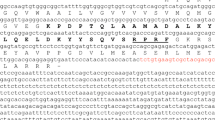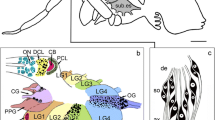Summary
-
1.
The central nervous system (CNS) of the freshwater snailLymnaea stagnalis contains several clusters of neuroendocriene cells, which synthesize neuropeptides that act as neurotransmitters, neurohormones, and/or neuromo-dulators, controlling a broad range of physiological processes. Using a protein chemical approach, we have previously characterized a peptide [named LYCP-A (Hoeket al., 1992], which is produced by the neuroendocrine light yellow cells (LYC), which are present as two clusters of endogenously bursting neurons in the visceral and right parietal ganglion, respectively.
-
2.
A differential screening technique was used to isolate the cDNA that encodes the prohormone of LYCP-A. The prohormone appeared to contain three or four putative neuropeptides, one of which is LYCP-A. The organization of the identified prohormone resembles that of the histidine-rich basic peptide precursor previously identified in the R3-14 neurons of the marine snailAplysia californica (Campanelli and Scheller, 1987).
-
3.
In situ hybridization analysis indicates that the gene encoding the LYC prohormone is expressed in a subset of the LYC. The LYC release their peptides into the hemolymph from a neurohemal area, which is located around the CNS. In addition, the peptides are released from axonal branches in the aorta of the heart, suggesting a role in the regulation of cardiovascular functions.
Similar content being viewed by others
References
Campanelli, J. T., and Scheller, R. H. (1987). Histidine-rich basic peptide: A cardioactive neuropeptide fromAplysia neurons R3-R14.J. Neurophysiol. 571201–1209.
Chirgwin, J. M., Przybyla, A. E., MacDonald, R. J., and Rutter, W. J. (1979). Isolation of biologically active ribonucleic acid from sources enriched in ribonuclease.Biochemistry 185294.
Chomczynski, P., and Sacchi, N. (1987). Single-step method of RNA isolation by acid guanidinium thiocyanate-phenol-chloroform extraction.Anal. Biochem. 162156–159.
Hoek, R. M., Li, K. W., and Geraerts, W. P. M. (1992). Chemical characterization of a novel peptide from the neuroendocrine light yellow cells ofLymnaea stagnalis.Mol. Brain Res. 1671–74.
Jirkowski, G. F., Sanna, P. P., and Bloom, F. E. (1990). mRNA coding for oxytocin is present in axons of the hypothalamo-neurohypophysial tract.Proc. Natl. Acad. Sci. USA 877400–7404.
Koester, J., and Koch, U. T. (1987). Neuronal control of the circulatory system ofAplysia.Experientia 43972–980.
Maniatis, T., Fritsch, E. F., and Sambrook, J. (Eds.) (1982).Molecular Cloning, a Laboratory Manual, Cold Spring Harbor Laboratory, Cold Spring Harbor, NY.
Meester, I., Ramkema, M. D., van Minnen, J., and Boer, H. H. (1992). Differential expression of four genes encoding molluscan insulin-related peptides in the central nervous system of the pond snailLymnaea stagnalis.Cell Tissue Res. 269183–188.
Mohr, E., Fehr, S., and Richter, D. (1991). Axonal transport of neuropeptide encoding messenger RNAs within the hypothalamohypophyseal tract of rats.EMBO J. 102419–2424.
Nagle, G. T., Knock, S. L., Painter, S. D., Blankenship, J. E., Fritz, R. R., and Kurosky, A. (1989). I.Aplysia californica neurons R3-R14: Primary structure of the myoactive histidine-rich basic peptide and peptide I..Peptides 10849–857.
Nakayama, K., Watanabe, T., Kim, W.-S., Nagahama, M., Hosaka, M., Hatsuzawa, K., Kondoh-Hashiba, K., and Murakami, K., (1992). Consensus sequence for precursor processing at mono-arginyl sites.J. Biol. Chem. 26716335–16340.
Price, C. H., and McAdoo, D. J. (1979). Anatomy and ultrastructure of the axons and terminals of neurons R3–R14 inAplysia.J. Comp. Neurol. 188 647–678.
Rothman, B. S., Sigvardt, K. A., Hawke, D. H., Brown, R. O., Shively, J. E., and Mayeri, E., (1985). Identification and primary structure analysis of peptide II, an end-product of precursor processing in cells R3–R14 ofAplysia.Peptides 61113–1118.
Sanger, F., Nicklen, S., and Coulson, A. R. (1977). DNA sequencing with chain-terminating inhibitors.Proc. Natl. Acad. Sci. USA 745463–5467.
Smit, A. B., Vreugdenhil, E., Ebberink, R. H. M., Geraerts, W. P. M., Klootwijk, J., and Joosse, J. (1988). Growth-controling molluscan neurons produce the precursor of an insuline-related peptide.Nature 331535–538.
van Minnen, J., Smit, A. B., and Joosse, J. (1989). Central and peripheral expression of genes coding for egg-laying inducing and insulin related peptides in a snail.Arch. Histol. Cytol. 52241–252.
van Swigchem, H. (1981). Electrotonic coupling within a cluster of neurosecretory endogenous oscillators inLymnaea stagnalis (L.).Comp. Biochem. Physiol. 68A 199–209.
van Swigchem, H., Lodder, J. C., and de Boer, Th. S. T. (1981). Localization and properties of the axons of neurosecretory bursting pacemaker cells inLymnaea stagnalis (L.).Proc. Kon. Ned. Akad. Wet. C 8449–62.
van Heijne, G. (1983). Patterns of amino acids near signal-sequence cleavage sites.Eur. J. Biochem. 13317–21.
Vreugdenhil, E., Jackson, J. F., Bouwmeester, T., Smit, A. B., van Minnen, J., van Heerikhuizen, H., Klootwijk, J., and Joosse, J., (1988). Isolation, characterization and evolutionary aspects of a cDNA clone encoding multiple neuropeptides involved in the stereotyped egg-laying behavior of the freshwater snailLymnaea stagnalis.J. Neurosci. 84184–4191.
Wendelaar Bonga, S. E. (1970) Ultrastructure and histochemistry of neurosecretory cells and neuroheamal areas in the pond snail Lymnaea stagnalis (L.)Z. Zellforsch. 108190–224.
Author information
Authors and Affiliations
Rights and permissions
About this article
Cite this article
Smit, A.B., Hoek, R.M. & Geraerts, W.P.M. The isolation of a cDNA encoding a neuropeptide prohormone from the light yellow cells ofLymnaea stagnalis . Cell Mol Neurobiol 13, 263–270 (1993). https://doi.org/10.1007/BF00733754
Received:
Accepted:
Issue Date:
DOI: https://doi.org/10.1007/BF00733754




